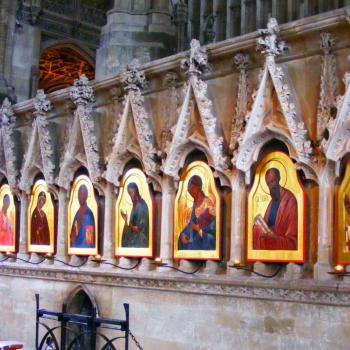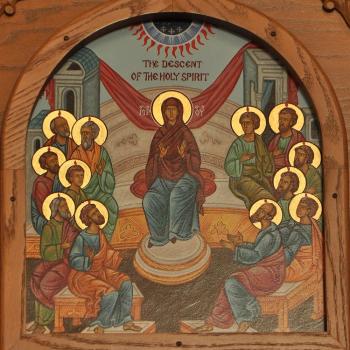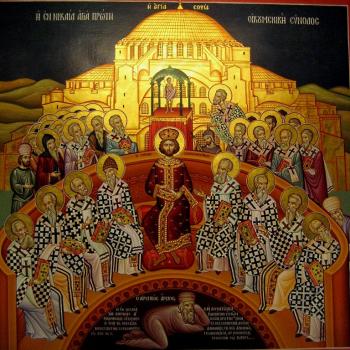![Baptism/Chrismation at a Georgian Orthodox Church by Paata Vardanashvili from Tbilisi, Georgia (christening) [CC BY 2.0 (http://creativecommons.org/licenses/by/2.0)], via Wikimedia Commons](https://wp-media.patheos.com/blogs/sites/637/2017/06/Baptism_at_a_Georgian_church-300x200.jpg)
Thanks to grace, thanks to the proper invocation over the oil, over the chrism, it can become a vessel of grace, so that those anointed by it, can and will receive the gift of the Holy Spirit. To help the newly baptized and chrismated believers understand this, St. Cyril of Jerusalem used the eucharist as an example, showing how God can and does change material things for his purpose, transforming them to be something more than what they appear to be by our senses:
But beware of supposing this to be plain ointment. For as the Bread of the Eucharist, after the invocation of the Holy Ghost, is mere bread no longer , but the Body of Christ, so also this holy ointment is no more simple ointment, nor (so to say) common, after invocation, but it is Christ’s gift of grace, and, by the advent of the Holy Ghost, is made fit to impart His Divine Nature.[2]
As for the invocation over the chrism, it is not something anyone can do, but only those who have full apostolic authority, those who are successor of the apostles as bishops, just as the apostles and those they transferred their authority to could lay on hands in the earliest era of the church. Priests can use the chrism to confirm the newly baptized, but only bishops can render the chrism ready for the sacrament:
Although it is permitted to priests either without a bishop, or with a bishop present, to anoint the baptized with chrism when they baptize, they may only do so with chrism that has been consecrated by the bishop. [3]
The actual ritual is well described by St. Bonaventure, explaining how the chrism is placed upon the one being confirmed, allowing them to be enlightened by the Holy Spirit:
As to the sacrament of confirmation, we must admit that a vocal form is required for its integrity. According to the more common practice it is: I sign thee with the sign of the cross and confirm thee with the chrism of salvation in the name of the Father and of the Son and of the Holy Ghost. Amen. Chrism is also required, and this is made up of olive oil and balsam. When the sign of the cross is marked with chrism on the forehead by the hand of the bishop with the aforenamed arrangement of the words of confirmation, the sacrament is received and man is strengthened by it so that as a fighter he must boldly and publicly acknowledge the name of Christ.[4]
It might seem strange to suggest that the laying on of hands by the Apostles was an anointing in and with the use of oil; however, it should not be surprising once we are reminded that God had already established such forms of anointing was to be done through physical means with oil in the Mosaic Covenant (“And you shall take the anointing oil, and pour it on his head and anoint him” Ex. 29:7 RSV). The anointing of kings and priest was in and through oil, and in and through it there were filled with grace to fulfill their mission on earth. They foreshadowed the fulfillment of all such anointing in Christ, the true and proper anointed one, and so, with the way God used oil to share in the gifts of the Holy Spirit in Mosaic times, it should not be too surprising that we will continue to use oil for sharing in the anointing of Christ himself. Just as circumcision foreshadowed baptism, so the anointing which was had by priests and kings became the source and foundation by which Christians were to be anointed in Christ, and truly become priests and kings in Christ (“But you are a chosen race, a royal priesthood, a holy nation, God’s own people, that you may declare the wonderful deeds of him who called you out of darkness into his marvelous light” 1 Ptr. 2:9 RSV). We are anointed, and so become christs ourselves, representatives of Christ in the world. Once anointed, we can be led by the Spirit, having become strengthened by the Spirit and all it gifts, as St. Ambrose explained to those who had just been baptized and confirmed:
There follows a spiritual sign which you heard read today, because after the font there remains the effecting of perfection, when at the invocation of the priest the Holy Spirit is poured forth, ‘the spirit of wisdom, and of understanding, the spirit of counsel, and of virtue, the spirit of knowledge, and of godliness, the spirit of holy fear,’ as it were, seven virtues of the Spirit.[5]
The Holy Spirit, therefore, comes to us through the means the church has received unto itself since the time of the Apostles. We are to be sealed in the Spirit, anointed with holy chrism, so we can properly take on the mantle of Christ for ourselves.
[1] St. John of Damascus, “Exposition of the Orthodox Faith” in NPNF2(9): 79.
[2] St. Cyril of Jerusalem, Catechetical Lecture XXI in NPNF2(7): 150.
[3] St. Isidore of Seville, De Ecclesiasticis Officiis. Trans. Thomas L. Knoebel, PhD (New York: Newman Press, 2008),113.
[4] St. Bonaventure, Breviloquium. Trans. Erwin Esser Nemmers (St. Louis, MO: B. Herder, 1946), 194.
[5] St. Ambrose, “The Sacraments,” in Theological and Dogmatic Works. trans. Roy J Deferrari, PhD (Washington, DC: Catholic University of America Press, 1963), 293.
Stay in touch! Like A Little Bit of Nothing on Facebook:
A Little Bit of Nothing














